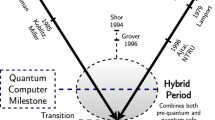Abstract
The latest advances in quantum computing forced the NIST to launch an initiative for selecting quantum-resistant cryptographic algorithms. One of the best-known proposals is NewHope, an algorithm that was initially designed as a key-exchange algorithm. In its original design, NewHope presented a reconciliation mechanism that is complex and represents an entry barrier for potential implementers. This contribution presents equivalent schemes in one, two, and three dimensions, which allow anyone to make the transition to the four-dimension NewHope algorithm easier to undertake.
Access this chapter
Tax calculation will be finalised at checkout
Purchases are for personal use only
Similar content being viewed by others
References
NIST: Public-key post-quantum cryptographic algorithms (2016). https://csrc.nist.gov/News/2016/Public-Key-Post-Quantum-Cryptographic-Algorithms. Last Accessed 21 Apr 2020
NIST: Post-quantum cryptography (2017) https://csrc.nist.gov/Projects/post-quantum-cryptography. Last Accessed 21 Apr 2020
Alkim, E., Avanzi, R., Bos, J., Ducas, L., de la Piedra, A., Pöppelmann, T., Schwabe, P., Stebila, D.: NewHope (2017). https://www.newhopecrypto.org. Last Accessed 21 Apr 2020
Alkim, E., Avanzi, R., Bos, J., Ducas, L., de la Piedra, A., Pöppelmann, T., Schwabe, P., Stebila, D.: NewHope. Algorithm specifications and supporting documentation (2019). https://www.newhopecrypto.org/data/NewHope_2019_07_10.pdf. Last Accessed 21 Apr 2020
Alkim, E., Ducas, L., Pöppelmann, T., Schwabe, P.: Post-quantum key exchange - a new hope. In: Proceedings of the 25th USENIX Security Symposium, pp. 327–343 (2016)
Ding, J., Xie, X., Lin, X.: A simple provably secure key exchange scheme based on the learning with errors problem. Cryptology ePrint Archive, Report 2012/688, pp. 1–15 (2012). https://eprint.iacr.org/2012/688. Last Accessed 21 Apr 2020
Peikert, C.: Lattice cryptography for the internet. In: Mosca, M., (ed.) Post-Quantum Cryptography, pp. 197–219. Springer International Publishing (2014)
Langley, A.: Post-quantum key agreement (2015). https://www.imperialviolet.org/2015/12/24/rlwe.html. Last Accessed 21 Apr 2020
Ducas, L.: Newhope’s reconciliation mechanism explained (2016). https://homepages.cwi.nl/~ducas/weblog/NewhopeRec/index.html. Last Accessed 21 Apr 2020
Micciancio, D., Regev, O.: Lattice-based cryptography. In: Bernstein, D.J., Buchmann, J., Dahmen, E. (eds.) Post-Quantum Cryptography, pp. 147–191. Springer, Berlin, Germany (2009)
Regev, O.: On lattices, learning with errors, random linear codes, and cryptography, pp. 84–93 (2005)
Peikert, C.: Public-key cryptosystems from the worst-case shortest vector problem: extended abstract. In: STOC 2009, pp. 333–342 (2009)
Lyubashevsky, V., Peikert, C., Regev, O.: On ideal lattices and learning with errors over rings. Lecture Notes Computer Science, vol. 6110, pp. 1–23 (2010)
NIST: SHA-3 Standard: Permutation-Based Hash and Extendable-Output Functions. National Institute of Standards and Technology, NIST FIPS PUB 202, March 2015
Alkim, E., Ducas, L., Pöppelmann, T., Schwabe, P.: Post-quantum key exchange - a new hope. Cryptology ePrint Archive, Report 2015/1092 (2015). http://eprint.iacr.org/2015/1092. Last Accessed 21 Apr 2020
Acknowledgements
This work was supported in part by the Ministerio de Economía, Industria y Competitividad (MINECO), in part by the Agencia Estatal de Investigación (AEI), in part by the Fondo Europeo de Desarrollo Regional (FEDER, UE) under Project COPCIS, Grant TIN2017-84844-C2-1-R, and in part by the Comunidad de Madrid (Spain) under Project reference P2018/TCS-4566-CM (CYNAMON), also cofunded by European Union FEDER funds. Víctor Gayoso Martínez would like to thank CSIC Project CASP2/201850E114 for its support.
Author information
Authors and Affiliations
Corresponding author
Editor information
Editors and Affiliations
Rights and permissions
Copyright information
© 2021 The Editor(s) (if applicable) and The Author(s), under exclusive license to Springer Nature Switzerland AG
About this paper
Cite this paper
Gayoso Martínez, V., Hernández Encinas, L., Martín Muñoz, A. (2021). Study of the Reconciliation Mechanism of NewHope. In: Herrero, Á., Cambra, C., Urda, D., Sedano, J., Quintián, H., Corchado, E. (eds) 13th International Conference on Computational Intelligence in Security for Information Systems (CISIS 2020). CISIS 2019. Advances in Intelligent Systems and Computing, vol 1267. Springer, Cham. https://doi.org/10.1007/978-3-030-57805-3_34
Download citation
DOI: https://doi.org/10.1007/978-3-030-57805-3_34
Published:
Publisher Name: Springer, Cham
Print ISBN: 978-3-030-57804-6
Online ISBN: 978-3-030-57805-3
eBook Packages: Intelligent Technologies and RoboticsIntelligent Technologies and Robotics (R0)




